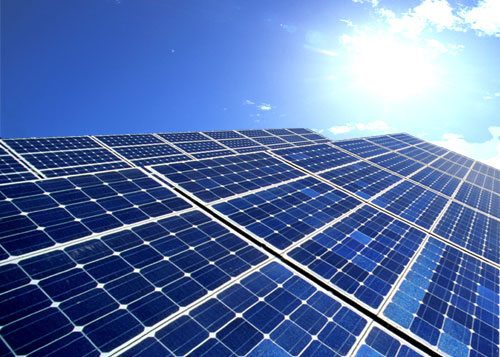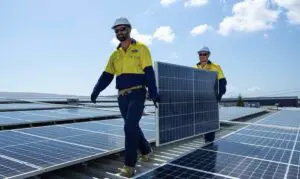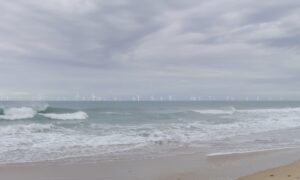Solar PV could provide 30 per cent of Australia’s electricity needs by 2030, according to the Australian Renewable Energy Agency, which has made further improvements and innovation in solar power one of its main investment priorities for the next few years.
ARENA on Monday unveiled its four main investment priorities, with a focus on battery storage and grid stability and reliability, solar PV innovation, lifting energy productivity and – as RenewEconomy foreshadowed last week – exporting renewable energy.
Storage and grid reliability and stability will be the main priorities, however, and could absorb up to half of the $800 million the agency has left in its budget. Much of this is expected to be committed – if not spent – in the next three years.
“We think we can have most impact in these four areas. This is where we are concentrating our efforts,” ARENA CEO Ivor Frischknecht said at the function at Melbourne’s Hub, an innovation centre in Bourke Street.
Frischknecht said Australia was on the path to an “affordable and reliable” renewable energy grid, thoughts echoed by the new CEO of the Australian Energy Market Operator, Audrey Zibelman, who repeated her assessment that Australia was at the forefront of the global energy transition.
“The future of energy industry going to look a lot like other industries that have been transformed,” Zibelman said. “It will need to be flexible and adaptable. It is not going to happen in decades, it is going to happen in a matter of years …. and maybe even shorter for some technologies.
“This is the best time ever to be in this industry. It’s the most exciting time. If you look at the changes from 1980-2005 and compare to what has happened since, it is just breathtaking. And it is getting faster.”
The pace of the change was underlined last week by the latest report by the CSIRO and the network owners, Energy Networks Australia, who said that households would be at the centre of a 100 per cent renewable energy grid that could be built within Australia before 2050, and deliver huge savings to consumers.
Zibelman agrees that consumers will be the focus of the new energy system. “We need to think about the power system differently. We need to think about developing the 21st Century grid from the customer out, rather than cstomer in.”
AEMO will work closely with ARENA, particularly on the first and most important of the investment priorities, which will focus on storage, grid smarts, and new business models.
Frischknecht said this would include further work on dealing with the variability o wind and solar, and “innovative ways to use, store, manage and share renewable energy.” The technologies were there, he and Zibelman underlined, it was a matter of learning how to deploy them at scale.
ARENA would look to reduce the cost of integrating renewable energy, increase the value of renewable energy, and help decarbonise the electricity grid.
These programs would include flexible capacity, and this would include solar thermal and other storage technologies such as pumped hydro, but also battery storage and the business models associated with that.
“It could be a project that demonstrate how the rules ought to be changed,” Frischknecht said. “For example, a big battery, we don’t really know how they are going to make money. We know the potential revenue stack, but we don’t know how much we can make in each one, or what the impediments are to realising them.”
The second major funding priority is further innovation in solar PV. Australia is a world leader is solar, and Frischknecht said the costs were falling rapidly – as had been demonstrated by the hugely successful large scale solar tender.
Australia, he said, could be powered 30 per cent by solar by 2030, particularly if the cost of solar falls to less than 6c/kWh and market conditions allow. Some salar experts say solar costs are not far off that level, and falling fast.
“A key foundation is to make solar dirt cheap. I think we will get there,” Frischknecht said.
The idea of Australia’s grid being powered 30 per cent by solar is one that is derided by conservative politicians and commentators, but appears increasingly likely.
As RenewEconomy reports in new stories here, here and here today, solar projects are growing quickly, particularly in Queensland. There are now more than 30 large scale solar farms either completed, under construction, or about to be built – which will add at least 2,200MW to the grid by the end of 2018 alone.
And the uptake of rooftop solar is also increasing rapidly, and the CSIRO study predicts huge amounts of solar and storage to be installed by home-owners and businesses over the coming decades, helping reduce their own electricity costs, but also for all consumers.
Frischknecht said reducing solar PV costs would also make it cheaper to build “excess solar PV capacity, which could be used to charge storage, and also as a foundation for renewable energy exports, which is another major ARENA priority.
Frischknecht said that three quarters of the energy produced in Australia was destined for export in the form of coal and LNG. “We would like to turn renewable energy into a similar export industry,” he said.
Hydrogen and ammonia would be considered as potential “vectors”, and also embodying renewable energy in mineral exports, by using wind and solar to power the extraction, refining and export of commodities like iron and aluminium. This could more than double the value of some mineral exports.
This work would largely focus on feasibility studies, and supply chain analysis, as well as small scale and low cost trials and pilots.
The fourth pillar would be energy productivity, to help accelerate the improvement in Australia’s energy productivity, which is currently planned to increase 40 per cent from 2015 to 2030, but which most analysts say could occur much quicker.
This would include energy efficiency, electrification of vehicles (EVs etc), industial heat and fuel switching to renewable energy sources. It appears particularly relevant at a time when consumers and polticians are railing against the potential of a gas shortfall and sky-rocketing prices, particularly when there are many alternatives available.
Frischknect said ARENA would look at new ways to address barriers to the adoption of associated technologies. “Our energy productivity is low,” he said.
Solar thermal technologies would fit both the reliability and productivity investment priorities, particularly with the use of heat in industrial processes.
Last month, the Coalition announced it would provide $110 million – over and above ARENA and CEFC backing – for a solar tower and storage plant in Port Augusta.
It said it would ask ARENA to conduct a feasibility study into any such projects. ARENA said an announcement would be made “soon.”










